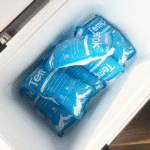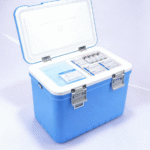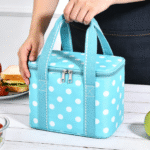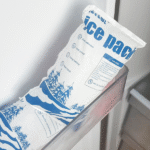Updated: August 13, 2025. This article merges the strongest ideas from your three drafts into one best‑in‑class resource.
Dry ice packs for shipping flowers can keep blooms cool without freezing—if you use the right container, buffers, and labels. Most cut flowers travel best near 0–2 °C, while tropicals need warmer air. Below you’ll get simple packouts, 2025 compliance steps (UN1845), and a calculator you can copy to size cooling for 24–96 hours. UC Davis and IFAS guidance back the temperature targets.
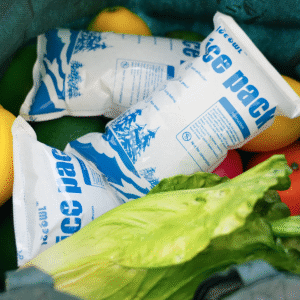
This article will help you:
-
Choose when dry ice packs for shipping flowers make sense (vs. gel/PCM) for different species and routes.
-
Pack flowers to avoid freeze damage with dividers, liners, and airflow.
-
Pass 2025 rules: UN1845 marks, acceptance checklists, and postal limits.
-
Estimate cooling for 24–96 h and pick the right shipper (EPS/EPP/VIP).
-
Track quality with simple tools (loggers, indicators) and a quick lane selector.
When are dry ice packs for shipping flowers the right choice?
Direct answer: Use dry ice packs for shipping flowers on hot, long routes (48–96 h) and hardy species; prefer 0 °C PCM gel packs for typical lanes. Keep dry ice isolated, vented, and never in contact with petals. Most temperate flowers hold best near 0–2 °C; tropicals are chilling‑sensitive and should not see near‑freezing air.
Why this balance works: Think of dry ice as a “boost” for extreme heat or long transit. Temperate roses, mums, irises and similar stems tolerate near‑freezing storage; orchids, anthurium, and heliconia prefer 10–12 °C and can suffer chilling injury below that range. On most lanes, PCM 0 °C gel packs provide safer cooling with less risk. For summer heat or 72 h delivery, a hybrid (PCM near stems + a small dry‑ice charge above a rigid tray) adds staying power without freezing.
How does a hybrid packout prevent freezing?
Place PCM around stems to hold ~0–2 °C. Add a rigid, vented divider. Top‑load a modest dry‑ice charge so cold sinks through the divider but doesn’t flash‑freeze petals. Always leave a vent path for CO₂. This layout stretches duration and evens temperatures through the carton.
| Packout Option | Typical Hours | Risk Level | What it means for you |
|---|---|---|---|
| PCM 0 °C only | 24–48 | Low | Best for most SKUs and overnight lanes. |
| Dry ice only | 24–72 | Medium–High | Powerful but freeze‑risk without divider/vent. |
| Hybrid (PCM + dry ice) | 48–96 | Low–Medium | Long hot lanes; balanced, safer temps. |
Practical tips you can use
-
Top‑load dry ice over a rigid tray; keep a 25–50 mm standoff above petals.
-
Minimize headspace with void fill so cold air doesn’t “pool” unevenly.
-
Poly‑bag bouquets loosely to limit drying; perforate above the divider for venting.
Field case: A Dutch exporter moved 5,000 tulips to the Gulf in midsummer. Using a VIP shipper + 0 °C PCM around stems and a small dry‑ice charge above a tray held ~1–2 °C for ~30 hours; flowers arrived event‑ready with no petal burn.
How do you pack flowers with dry ice packs for shipping flowers without freezing?
Direct answer: Buffer, separate, and vent. Put PCM near stems, use a rigid, vented divider, top‑load dry ice, and keep any coolant from touching petals. This keeps air in the safe band and avoids cold spots.
Step‑by‑step approach: Pre‑cool hydrated stems. Line the carton (EPS/EPP/VIP). Add PCM bricks around stems. Fit a rigid tray. Place small dry‑ice bags on the tray. Close the liner without sealing airtight and mark UN1845 + net kg on the long panel. Add a simple temperature indicator or logger at petal height for proof and tuning.
Gel/PCM vs. “true” dry ice—what’s the difference?
Gel/PCM packs hold near 0 °C—ideal for most florals. “True” dry ice is −78.5 °C and can freeze petals on contact. When you must use dry ice, the divider and standoffs are non‑negotiable.
| Cooling method | Typical temp | Duration | Meaning for flowers |
|---|---|---|---|
| PCM 0 °C gel pack | ~0–2 °C | 24–48 h | Safe range for most cut flowers. |
| Dry ice (UN1845) | −78.5 °C source | 24–72 h | Powerful; isolate & vent. |
| Hybrid | ~0–2 °C | 48–96 h | Long lanes with safety margin. |
Actionable reminders
-
Wrap dry‑ice bags in a fabric sleeve to soften radiant cold.
-
Use “This Side Up” and “Perishable” handling notes to avoid inversion.
-
Ship mid‑week overnight to dodge weekend holds.
What rules govern dry ice packs for shipping flowers in 2025?
Direct answer: For air, follow IATA PI 954 and the 2025 Dry Ice Acceptance Checklist. Mark the package “Dry ice/Carbon dioxide, solid,” UN1845, and net kilograms; include shipper/consignee addresses and ensure venting. U.S. DOT 49 CFR §173.217 requires venting and specific marks; USPS air caps dry ice at ≤5 lb and prohibits it internationally. Carriers (FedEx/UPS) echo these requirements.
Why this matters: Correct labels and marks prevent dockside refusals and delays. FedEx’s 2025 job aid calls out UN1845 text sizing and visible shipper/consignee details. UPS highlights the 2.5 kg threshold language and PI 954 for international moves. Keep packages not airtight so CO₂ can escape safely.
Postal & operator highlights (quick check)
| Requirement | Applies to | Meaning for you |
|---|---|---|
| UN1845 + net kg + addresses | Air/ground parcels | Put marks on a vertical side, not the top/bottom. |
| Venting (not airtight) | All modes | Prevents pressure buildup/rupture. |
| USPS ≤5 lb (air) | U.S. domestic air | Above this, use other carriers/modes. No international postal dry ice. |
How much cooling do you need for 24–96 hours?
Direct answer: As a planning start, budget ~2.3–4.5 kg of dry ice per 24 h per parcel depending on insulation and ambient, then add 20–30% buffer. CO₂’s enthalpy of sublimation (~26 kJ/mol, ≈571 kJ/kg) explains the burn‑rate math. Validate with a simple data logger and tune.
Copy‑paste estimator (baseline only):
Quick selector—what should you use?
-
Overnight, mild weather: PCM 0 °C only.
-
48–72 h, summer lane: Hybrid (PCM + small dry‑ice top‑load).
-
Tropicals (orchids, anthurium): No dry ice; use 10–12 °C PCM.
Which containers pair best with dry ice packs for shipping flowers?
Direct answer: Choose the shipper before the coolant. EPS is cost‑effective for ≤48 h, EPP for rough handling/limited reuse, and VIP for 48–96 h hot lanes because it slashes heat leak (and your dry‑ice mass). Always provide a vent path for CO₂.
What this means on the floor: VIP hybrids shrink the carton and reduce “cold shock.” A vented divider and non‑airtight liner are essential regardless of foam type.
| Container | Lanes | Cooling impact | Practical note |
|---|---|---|---|
| EPS (25–40 mm) | 24–48 h | Higher ice mass | Budget starter; test in summer. |
| EPP (30–50 mm) | 36–72 h | Moderate mass | Durable and reusable. |
| VIP hybrid | 48–96 h | Lowest mass | Best for heat waves and long routes. |
2025 developments & trends in floral cold chain
What’s new: Carriers standardized acceptance checks for dry ice (UN1845); the IATA 2025 acceptance checklist is now a common origin touchpoint. On the horticulture side, research still centers on near‑freezing storage for temperate flowers and warmer setpoints for tropicals. Affordable Bluetooth loggers are now common for lane validation.
Latest at a glance
-
Carrier clarity: FedEx calls out UN1845 text size and mark placement to speed acceptance.
-
Postal specifics: USPS caps dry ice at ≤5 lb for domestic air; international postal routes prohibit it.
-
Physics baseline: CO₂ ΔH_sub ~26 kJ/mol is a reliable sanity check for your sizing math.
Market insight: VIP adoption is rising on long, hot lanes as brands trade “more ice” for “better insulation,” cutting dim‑weight and freeze risk.
FAQs
1) Is it safe to use dry ice packs for shipping flowers with all species?
No. Use for temperate stems (roses, mums, tulips) on hot/long lanes. Avoid for tropicals; use warmer PCM (10–12 °C).
2) How much dry ice per day should I plan?
Roughly 2.3–4.5 kg/24 h per parcel; add 20–30% buffer and verify with a logger on first runs.
3) What must be on the box for air shipments?
“Dry ice/Carbon dioxide, solid,” UN1845, net kg, shipper and consignee addresses; ensure venting and follow operator checklists.
4) Can I mail dry ice by USPS?
Domestic air: yes, up to 5 lb; international mail: prohibited. Follow Pub 52 and PI 9A.
5) What storage temperature should I target for most flowers?
Aim for 0–1 °C unless the species is tropical.
6) Do I need a Shipper’s Declaration?
Not when dry ice is shipped alone or with non‑DG under PI 954; still complete acceptance items and marks. Check operator variations.
About Tempk
We design floral cold‑chain packouts for growers, wholesalers, and DTC brands. Our programs tune container + coolant to your lanes, standardize labels and paperwork, and reduce excursions. Clients routinely cut warm events 20–40% after implementation. Talk to us for a regulation‑ready plan to deploy dry ice packs for shipping flowers this season.

















